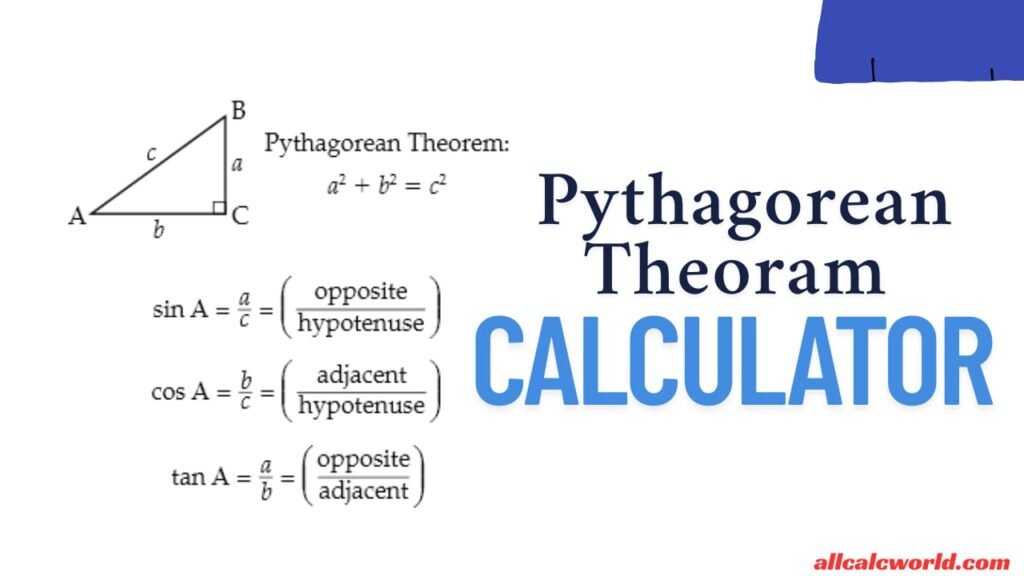Pythagorean Theorem Calculator
Calculate the missing side of a right-angled triangle
Pythagorean Theorem Calculator
The Pythagorean Theorem Calculator It’s not just a tool; it’s a fundamental law governing right-angled triangles, whispering secrets about distance, structure, and the very fabric of our world.

Table of Contents
The Heart of the Matter: Triangles and Squares
Imagine a right-angled triangle. That crucial right angle (90 degrees) creates a special relationship between its three sides:
- The Legs (a & b): The two sides that form the right angle. Shorter, longer – it doesn’t matter; they are the builders of the corner.
- The Hypotenuse (c): The side opposite the right angle. Always the longest side, stretching across the triangle’s diagonal.
Pythagoras’ Insight (c. 500 BC):
The area of the square built on the hypotenuse (c²) is exactly equal to the sum of the areas of the squares built on the two legs (a² + b²).
In its iconic equation:a² + b² = c²
Why Squares? The Visual Proof
The theorem’s genius lies partly in its visualizability. Picture it:
- Draw your right-angled triangle.
- Construct a square outward from each side. The square on side
ahas areaa * a = a². Similarly forbandc. - The Revelation: The total area covered by the two smaller squares (
a² + b²) will perfectly match the area of the largest square (c²). No overlap, no gap. It’s a geometric guarantee.
This visual proof (one of many!) demonstrates the theorem’s profound truth: Lengths and areas in a right triangle are locked in an unbreakable relationship defined by squares.
The Power Unleashed: Why It Matters
Understanding the theory reveals the theorem’s immense power:
- Finding the Missing Piece: It’s the ultimate detective for right triangles. Know two sides? The third is revealed. Need the ladder length (
c) to reach a window? Know the ground distance (a) and height (b)? Pythagoras delivers. Need the distance between points on a map? Plot them as a right triangle’s legs – the hypotenuse is the straight-line distance. - Foundation of Distance: It’s the mathematical engine behind the distance formula (
√[(x₂-x₁)² + (y₂-y₁)²]) used everywhere from GPS to game design. - Reality Check: Is a triangle right-angled? Plug in the side lengths. If
a² + b²exactly equalsc², that 90-degree angle is confirmed. - Building Blocks: From carpentry ensuring corners are square, to engineers calculating forces, to physicists modeling motion, the theorem underpins countless real-world applications. It translates geometry into actionable numbers.
More Than Memorization: The Conceptual Core
While a² + b² = c² is the famous slogan, the theory teaches us deeper lessons:
- Conservation of Area: The areas transform perfectly from the legs to the hypotenuse.
- The Primacy of the Right Angle: This specific angle creates this unique, predictable relationship. Change the angle, and the simple squares relationship vanishes.
- Universality: It works for every conceivable right-angled triangle, from microscopic to cosmic scales. The units (inches, meters, light-years) don’t matter; the relationship holds.
Before You Calculate: Grasp the Ground
A “Pythagorean Theorem Calculator” is a powerful tool, but it’s just an automated scribe. The real magic lies in the theory itself – the elegant, ancient, and utterly reliable relationship between the sides of a right triangle expressed through the language of squares.
Understanding why a² + b² must equal c², picturing those squares fitting together, and appreciating its universal truth transforms the theorem from a button-press into a fundamental key for unlocking spatial understanding. That’s the timeless power you carry, calculator or not. Master the concept, and you master the geometry that shapes our world.
FAQ For Pythagorean Theorem Calculator
Why does the theorem specifically use squares of the sides? Why not just the sides themselves?
The magic lies in the relationship of areas, not just lengths. Pythagoras discovered that the geometric area created by squaring each side reveals a perfect balance: The area of the square on the hypotenuse exactly equals the combined area of the squares on the two legs. This visual relationship (proven with arrangements of tiles or shapes) is what makes the theorem elegantly true and universally applicable. Using raw sides (a + b = c) simply doesn’t hold mathematically or geometrically.
Does the Pythagorean Theorem work for any triangle?
Only right-angled triangles! This is crucial. The theorem describes a unique, rigid relationship exclusive to triangles containing one 90-degree angle. If the triangle is acute or obtuse, the relationship breaks:
Acute: a² + b² > c²
Obtuse: a² + b² < c²
The Pythagorean Theorem (a² + b² = c²) is the definitive fingerprint of a right angle.
How is this ancient theorem still relevant today?
Its power transcends calculation—it’s a foundational law of geometry that shapes our understanding of space. The theorem proves that:
Distance is quantifiable: It’s the core of the “distance formula” (√(Δx² + Δy²)) used in GPS, mapping, physics, and computer graphics.
Structure is predictable: Builders use it to ensure corners are square; engineers use it to calculate forces and stresses in right-angled components.
Our world is mathematically connected: From measuring a soccer field to plotting a rocket’s trajectory, it confirms that right angles create an unbreakable geometric harmony.
If you have interest in Current Affairs than visit us on : https://realtimekhabar.com
Never Miss an Update!
Get the latest news, tips, and insights directly from us.